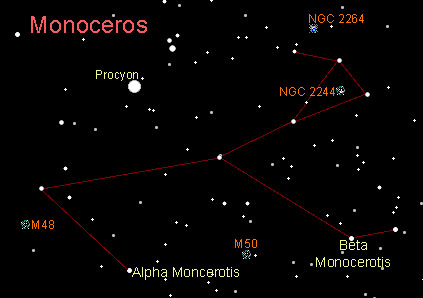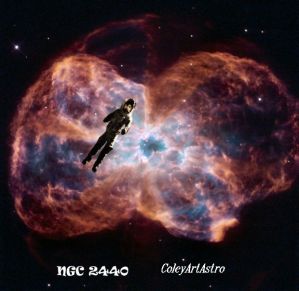Monoceros is nothing that interesting to look at with the naked eye as it contains no really bright stars. Those stars are: Alpha Monocerotis which has a visual magnitude of 3.93, slightly brighter than Gamma Monocerotis at 3.98.
This is one for the telescope owning astronomer as it does have interesting objects to see.
Deep-sky objects
Monoceros contains many clusters and nebulae, most notable among them:
- M50, an open cluster
- The Rosette Nebula (NGC 2237, 2238, 2239, and 2246) is a diffuse nebula in Monoceros. It has an overall magnitude of 6.0 and is 4900 light-years from Earth. The Rosette Nebula, over 100 light-years in diameter, has an associated star cluster and possesses many Bok globules in its dark areas. It was independently discovered in the 1880s by Lewis Swift (early 1880s) and Edward Emerson Barnard (1883) as they hunted for comets.
- The Christmas Tree Cluster (NGC 2264) is another open cluster in Monoceros. Named for its resemblance to a Christmas tree, it is fairly bright at an overall magnitude of 3.9; it is 2400 light-years from Earth. The variable star S Monocerotis represents the tree’s trunk, while the variable star V429 Monocerotis represents its top.
- The Cone Nebula (NGC 2264), associated with the Christmas Tree Cluster, is a very dim nebula that contains a dark conic structure. It appears clearly in photographs, but is very elusive in a telescope. The nebula contains several Herbig-Haro objects, which are small irregularly variable nebulae. They are associated with protostars.
- NGC 2254 is an open cluster with an overall magnitude of 9.7, 7100 light-years from Earth. It is a Shapley class f and Trumpler class I 2 p cluster, meaning that it appears to be a fairly rich cluster overall, though it has fewer than 50 stars. It appears distinct from the background star field and is very concentrated at its center; its stars range moderately in brightness.
- Hubble’s Variable Nebula (NGC 2261) is a nebula with an approximate magnitude of 10, 2500 light-years from Earth. Though it is named for Edwin Hubble, it was discovered in 1783 by William Herschel. Hubble’s Variable Nebula is illuminated by R Monocerotis, a young variable star embedded in the nebula; the star’s unique interaction with the material in the nebula makes it both an emission nebula and a reflection nebula. One hypothesis regarding their interaction is that the nebula and its illuminating star are a very early stage planetary system.

More Information:






You must be logged in to post a comment.